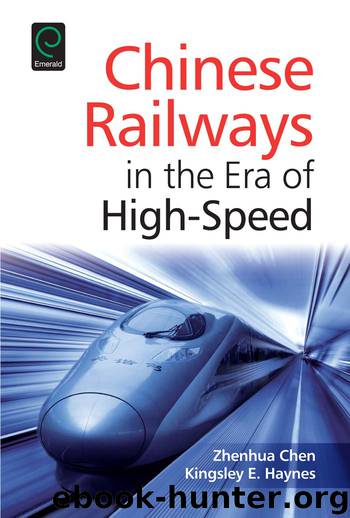Chinese Railways in the Era of High Speed by Chen Zhenhua; Haynes Kingsley E.;

Author:Chen, Zhenhua; Haynes, Kingsley E.;
Language: eng
Format: epub
Publisher: Emerald Group Publishing Limited
Published: 2015-08-06T16:00:00+00:00
4.3.3. The “7.23” HSR Accident
At 20:30:05 on July 23, 2011, the high-speed train D301 from Beijing South to Fuzhou collided with the high-speed train D3115, which was scheduled to travel from Hangzhou to Fuzhou South on the Ningbo-Taizhou-Wenzhou (Yongtaiwen) HSR line in the suburbs of Wenzhou, Zhejiang province, China. The accident interrupted the HSR line for 32 hours and 35 minutes and caused 40 deaths and 172 injuries. The direct economic loss was ¥193.72 million ($32.29 million).54 A strong thunderstorm damaged the fixed-data balises (track-mounted transponders) that linked the train control system LKD2-T1 and the train communication system. Lightning damaged a fuse, and the LKD2-T1 activated the automatic braking system of the D3115 train and sent false signals, permitting the D301 train access to the blocking section that was still occupied by the D3115.55 The damage to the train communications system cut further communications between the control center and the train drivers, which made manual attempts to avoid the collision impossible.56 The investigation initiated by the State Council indicates that the “7.23” HSR accident was caused by human error in conjunction with a serious design flaw in the train’s control equipment, compounded by the lack of strict supervision of the equipment, as well as the poor emergency response after the lightning strike.57
In particular, the accident exposed a series of human-related problems in the process of rail equipment R&D, facility bidding and installation, and operation and management. The China Railway Signal and Communication Corporation (CRSC) and its subordinate, the Beijing National Railway Research and Design Institute of Signal and Communication, were deemed responsible for the lack of supervision and management of R&D product quality, as well as for the flawed design of the LKD2-T1 train’s control system, because it did not apply the “fail-safe” principle.58 The former Ministry of Railways was singled out by the investigation group as responsible for the accident by failing to establish appropriate standards for infrastructure construction and for problems in the process of equipment bidding, procurement, technological audit, and facility installation. Because of the rush for project completion and the single-minded pursuit of construction speed, the former MOR was also blamed for overlooking safety concerns and emergency preparedness and response mechanisms.59 Last but not least, the Shanghai Railway Bureau rail operation and management was blamed for the lack of supervision and inspection of the system failure. The report indicates that the lack of effective measures to identify emergent events failed to prevent accidents and to mitigate the negative consequences of the accident.60
Download
This site does not store any files on its server. We only index and link to content provided by other sites. Please contact the content providers to delete copyright contents if any and email us, we'll remove relevant links or contents immediately.
| Automotive | Engineering |
| Transportation |
Small Unmanned Fixed-wing Aircraft Design by Andrew J. Keane Andras Sobester James P. Scanlan & András Sóbester & James P. Scanlan(32570)
Navigation and Map Reading by K Andrew(4884)
Endurance: Shackleton's Incredible Voyage by Alfred Lansing(4495)
And the Band Played On by Randy Shilts(2007)
Wild Ride by Adam Lashinsky(1863)
The Box by Marc Levinson(1854)
Top 10 Prague (EYEWITNESS TOP 10 TRAVEL GUIDES) by DK(1845)
The Race for Hitler's X-Planes: Britain's 1945 Mission to Capture Secret Luftwaffe Technology by John Christopher(1737)
The One Percenter Encyclopedia by Bill Hayes(1713)
Trans-Siberian Railway by Lonely Planet(1624)
Girls Auto Clinic Glove Box Guide by Patrice Banks(1615)
Looking for a Ship by John McPhee(1569)
Batavia's Graveyard by Mike Dash(1545)
TWA 800 by Jack Cashill(1519)
Fighting Hitler's Jets: The Extraordinary Story of the American Airmen Who Beat the Luftwaffe and Defeated Nazi Germany by Robert F. Dorr(1511)
Troubleshooting and Repair of Diesel Engines by Paul Dempsey(1495)
Good with Words by Patrick Barry(1493)
Bligh by Rob Mundle(1483)
Ticket to Ride by Tom Chesshyre(1476)
